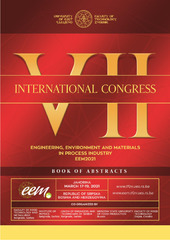Приказ основних података о документу
Amino acid imidayolium zwitterion as green corrosion inhibitor for mild steel
| dc.creator | Kovačina, Jovanka | |
| dc.creator | Jegdić, Bore | |
| dc.creator | Marunkić, Dunja | |
| dc.creator | Simović, Anđela | |
| dc.creator | Lazić, Dragana | |
| dc.creator | Marinković, Aleksandar | |
| dc.date.accessioned | 2023-12-13T22:31:18Z | |
| dc.date.available | 2023-12-13T22:31:18Z | |
| dc.date.issued | 2021 | |
| dc.identifier.isbn | 978-99955-81-38-1 | |
| dc.identifier.uri | https://cer.ihtm.bg.ac.rs/handle/123456789/7066 | |
| dc.description.abstract | Corrosion, although a natural process, presents a costly problem with the possibly dangerous outcome. Mild steel, which is an alloy used in many industrial applications, manifests poor corrosion resistance when in contact with corrosive environments and even more so in presence of chloride ions. This is a particularly important problem in a variety of industrial applications related to oil and gas processing such as pipeline cleaning pipeline/acid descaling, and oil well acidizing, where the use of mineral acids (commonly hydrochloric acid) is necessary for achieving satisfying productivity levels. The most practical method to combat the corrosion issue is the use of corrosion inhibitors. Organic inhibitors with functional groups such as –OH, – COOH, NH2, etc, when added in small concentrations to a corrosive solution, can lower the corrosion rate very efficiently, especially in acidic media. Being that they are also inexpensive, these organic inhibitors are successfully used for corrosion prevention. A great variety of organic inhibitors has opened a door to environmentally friendly corrosion inhibition. One of the environmentally friendly organic compounds are amino acids. They are non-toxic biomolecules completely soluble in aqueous media and are produced with high purity and at low cost which makes them a great candidate for a safe corrosion inhibitor. The application of amino acids and their derivatives against corrosion of iron and its alloys has been investigated so far. Amino acid based corrosion inhibitor was synthesized by condensing formaldehyde, glyoxal, and β-alanine, and characterized using FTIR and NMR spectroscopic methods. Imidazolium zwitterion has been investigated as a corrosion inhibitor on mild steel in 1 M HCl solution using electrochemical methods: electrochemical impedance (EIS) and linear polarization resistance (LPR). Different concentrations of inhibitor were used to find the best efficiency. This compound gave a maximum inhibition efficiency of 74.3 % at 10.7 ppm. The adsorption of inhibitor on mild steel surface followed the Langmuir adsorption isotherm. Furthermore, electrochemical measurement results demonstrated that inhibitors act as mixed-type inhibitors (anodic and cathodic). | sr |
| dc.language.iso | en | sr |
| dc.publisher | Faculty of Technology Zvornik – University of East Sarajevo | sr |
| dc.relation | info:eu-repo/grantAgreement/MESTD/inst-2020/200026/RS// | sr |
| dc.relation | info:eu-repo/grantAgreement/MESTD/inst-2020/200135/RS// | sr |
| dc.relation | info:eu-repo/grantAgreement/MESTD/inst-2020/200287/RS// | sr |
| dc.relation | info:eu-repo/grantAgreement/MESTD/inst-2020/200325/RS// | sr |
| dc.rights | openAccess | sr |
| dc.rights.uri | https://creativecommons.org/licenses/by-nc-nd/4.0/ | |
| dc.source | Book of abstracts - VII International congress Engineering, environment and materials in process industry EEM2021, March 17-19, 2021 Jahorina, Republic of Serbia, Bosnia and Herzegovina | sr |
| dc.subject | zwitterion | sr |
| dc.subject | corrosion inhibition | sr |
| dc.subject | mild steel | sr |
| dc.subject | green and organic chemistry | sr |
| dc.title | Amino acid imidayolium zwitterion as green corrosion inhibitor for mild steel | sr |
| dc.type | conferenceObject | sr |
| dc.rights.license | BY-NC-ND | sr |
| dc.citation.volume | 7 | |
| dc.citation.spage | 212 | |
| dc.citation.epage | 212 | |
| dc.identifier.rcub | https://hdl.handle.net/21.15107/rcub_cer_7066 | |
| dc.identifier.fulltext | http://cer.ihtm.bg.ac.rs/bitstream/id/27871/EEM_2021.pdf | |
| dc.type.version | publishedVersion | sr |


